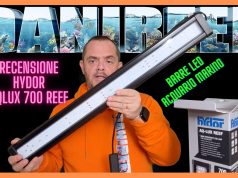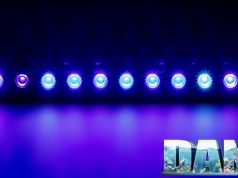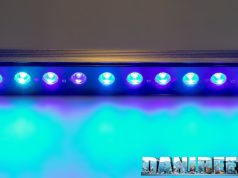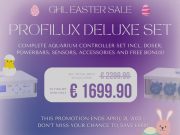How to value these numbers in aquarium?
This is a good question. At first we thought that we could transport these values to the aquarium tout-court. Than we filled the aquarium, insert the probe and redone the measurements. We fazed but, as we have already said in elsewhere, we’re going to talk about this in another article. Basically, while at 20 cm the result is practically the same, as we progressed, thanks to the glass and the water itself reflecting the light, we found even the double of the values measured in air. Obviously this isn’t a detail that can be standardized, so we think that our method of calculation is the most correct, and the best for the comparison of coverages of different ceiling lights.
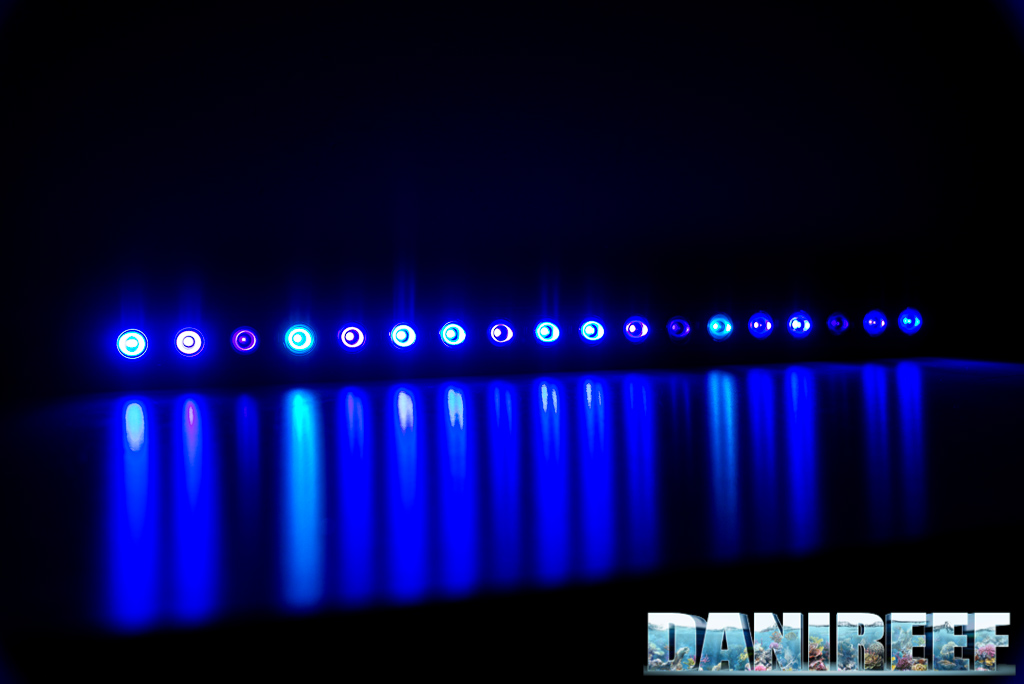
Power consumption
The measurement of the consumption was made possible thanks to the useful device RCE PM600 that can also measure the Cos(fi) (or power factor). The result is already given in watt.
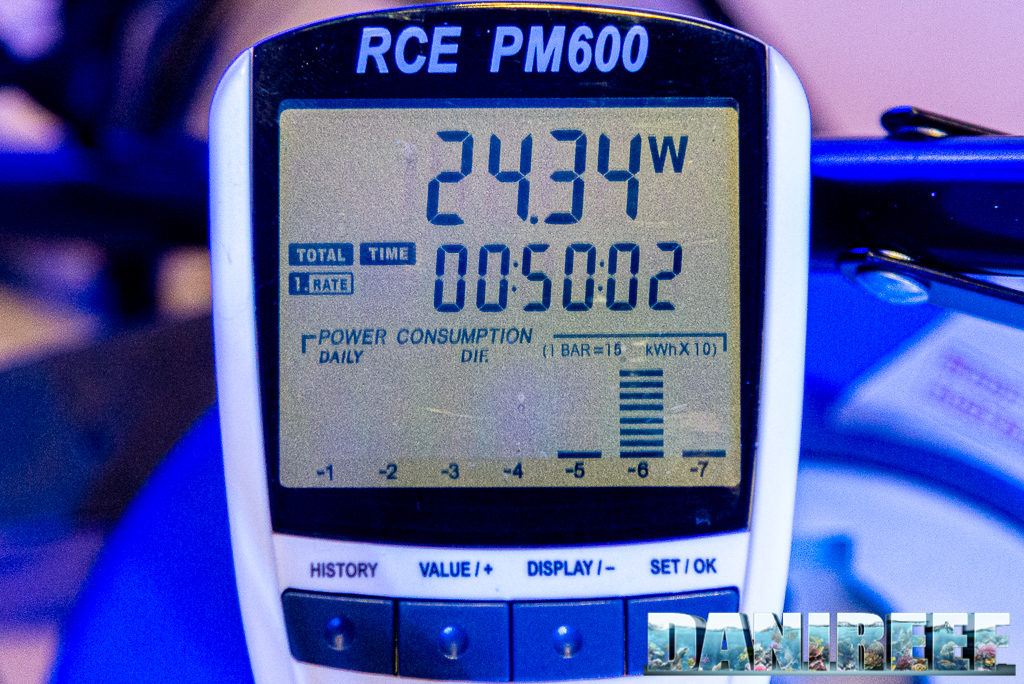
Here above there’s the maximum power and then the Cos(fi).
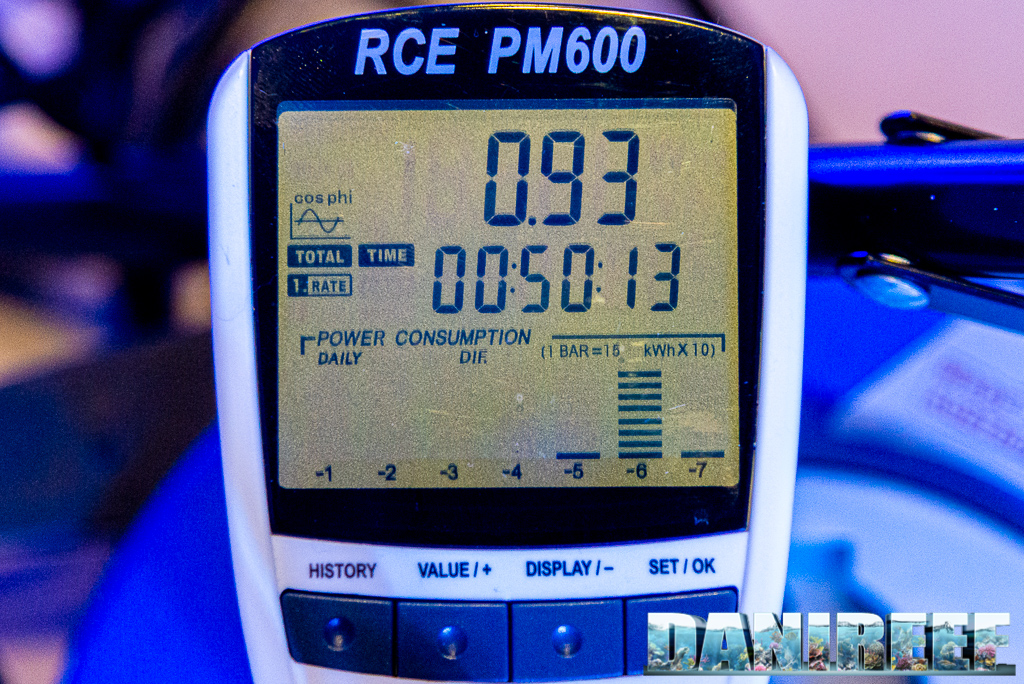
The calculation of the current absorbed, that is the power, is the following one:
The Reef Flare Bar Blue S consumes 24,34 watt. Considering that at 17 cm the ceiling light has 459 μmol m-2 s-1 in the middle, we can say, in perspective, that it’ll have a peak value of 18,86 μmol m-2 s-1 w-1 (PAR per watt). This value is easily comparable with other ceiling lights because it remains more or less costant throughout the length. The declared consumption is 34 watt, so according to our measures it takes one-third less. Whether this is positive or not I leave it to you, or let’s discuss in the comments.
But surely we have to admit that it’s very good a Cos(fi) higher than 0,90.
The comparison with other ceiling lights on the market
Here the data collected in the DaniReef LAB with the Quantum Meter MQ-510 by Apogee. We can do an interesting comparison between the ceiling lights:
| Lamp | Energy | Cost | Power consumption | Energy/€ | Energy/w |
| Orphek OR2 Blue Plus 120 cm at 17 cm | 323.000 | 180 | 54,69 | 1.794 | 5.906 |
| Orphek OR2 Blue Plus 120 cm at 37 cm | 291.000 | 180 | 54,69 | 1.616 | 5.321 |
| Orphek OR2 Blue Plus 120 cm at 57 cm | 259.000 | 180 | 54,69 | 1.438 | 4.736 |
| Orphek OR3 Blue Sky at 17 cm | 318.000 | 200 | 62,04 | 1.590 | 5.129 |
| Orphek OR3 Blue Sky at 37 cm | 220.767 | 200 | 62,04 | 1.103 | 3.449 |
| Orphek OR3 Blue Sky at 57 cm | 205.518 | 200 | 62,04 | 1.027 | 3.211 |
| Orphek OR2 Reef Day Plus 120 cm at 17 cm | 255.000 | 180 | 54,69 | 1.418 | 4.667 |
| Orphek OR2 Reef Day Plus 120 cm at 37 cm | 233.000 | 180 | 54,69 | 1.292 | 4.252 |
| Orphek OR2 Reef Day Plus 120 cm at 57 cm | 225.000 | 180 | 54,69 | 1.251 | 4.117 |
| Reef Flare Bar Blue S at 17 cm | 202.000 | 220 | 24,34 | 918 | 8.299 |
| Reef Flare Bar Blue S at 37 cm | 177.000 | 220 | 24,34 | 804 | 7.272 |
| Reef Flare Bar Blue S at 57 cm | 155.000 | 220 | 24,34 | 704 | 6.368 |
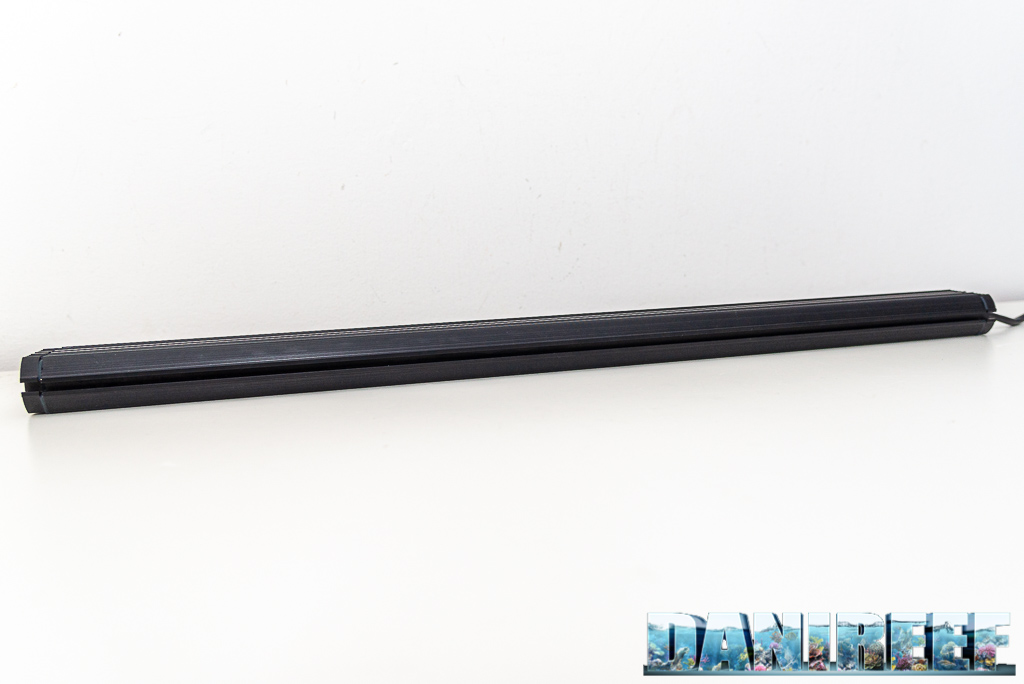
The comparison is very interesting. Compared to other bars the Orpheks, all of 120 cm, have a smaller peak value that is little affected by the length of the bars. The energy value, istead, is more affected by the length, so the gap may be closed by trying the 120 cm bar. What’s that stands out it the cost per PAR, which is higher. This means that the PAR are more expensive, but it’s cheaper producing them by the ceiling light, so in the end the power consumption is much lower for the same PAR produced. What leaves me a little perplexed is that the consumption is inferior to the declared, who know what this lamp might have achieved if…
Maintenance costs
The Reef Flare Bar Blue S cost 220 euro.
The absorbed power is 24,34 watt, then the cost/watt ratio is about 9 euro per each watt. For a comparison with the other ceiling lights you can consult the following chart. Notice that they’re sorted by decreasing efficiency, so the best ones are on top.
| Ceiling light | Price | Power consumption | Euro/watt ratio | References |
| Orphek OR3 Blue Sky | 200 USD | 62 w | 3,2 euro per watt | DaniReef LAB |
| Orphek OR2 Blue Plus | 180 USD | 54.7 w | 3,3 euro per watt | DaniReef LAB |
| Orphek OR2 Reef Day Plus | 180 USD | 54,7 w | 3,3 euro per watt | DaniReef LAB |
| Cetus 2 | 215 € | 60,7 w | 3,5 euro per watt | DaniReef LAB |
| Philips Coralcare 2019 | 749 € | 190 w | 3,9 euro per watt | DaniReef LAB |
| Maxspect Ethereal | 500 € | 126 w | 4,0 euro per watt | Italian test |
| Radion XR30w G2 PRO | 790 € | 170 w | 4,7 euro per watt | Italian review |
| AI Hydra 32 HD | 430 € | 90,5 w | 4,75 euro per watt | DaniReef LAB |
| Radion XR30w G4 PRO | 915 € | 190 w | 4,84 euro per watt | Italian article |
| OceanLed Sunrise 600 | 870 € | 180 w | 4,8 euro per watt | Italian test |
| Orphek Atlantik V4 | 1099 € | 226 w | 4,9 euro per watt | Test |
| Radion XR30w G2 | 690 € | 140 w | 4,9 euro per watt | Italian review |
| Radion XR30w G4 | 760 € | 150 w | 5,1 euro per watt | Italian article |
| Aqamai LRM | 465 € | 87,5 w | 5,1 euro per watt | DaniReef LAB |
| Zetlight UFO ZE-8000 | 500 € | 91,5 w | 5,5 euro per watt | Test |
| Aqamai LRS | 289 € | 47,6 w | 6,1 euro per watt | DaniReef LAB |
| Reef Flare Bar Blue S | 220 € | 24,34 w | 9 euro per watt | DaniReef LAB |
| CEAB Slide & Led | 2.700 € | 275 w | 9,8 euro per watt | Review |
| Sicce GNC 466 | 1.592 € | 120 w | 13,3 euro per watt | Review |
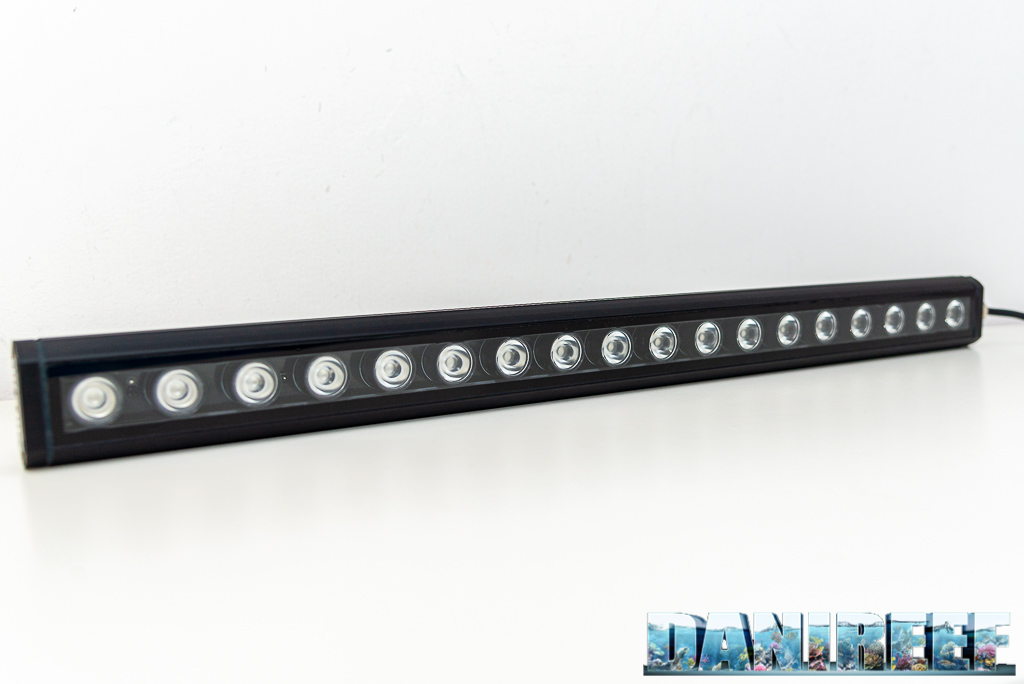
The ceiling light is very well built. It’s dimmable and with a very high technical efficiency (PAR per watt). The cost per watt is als high, probably because the ceiling light has also a dimming control that others don’t have. I love extruded profiles, as well as the finishing. As with other bars, you can combine more samples to obtain the power you need. This is how you should consider the PAR, since the comparison with other ceiling lights is obviously losing. But if you consider the total energy and the light you add, the counts add up. So these bars are perfect to breed any kind of coral, you just have to use the right number of bars. Do you want to double the PAR? Use two. Do you want to quadruplicate? Use four, and so on.
I think that five or six LED bars should reach about 600 PAR in a medium sized aquarium, depending on the depth, and this value allows us to breed Acropore of any kind of complexity.
The cost per watt is pretty high but the ceiling light has a very low consumption. So, you pay a little more at the beginning and then you’re going to save thanks to the low consumptions.
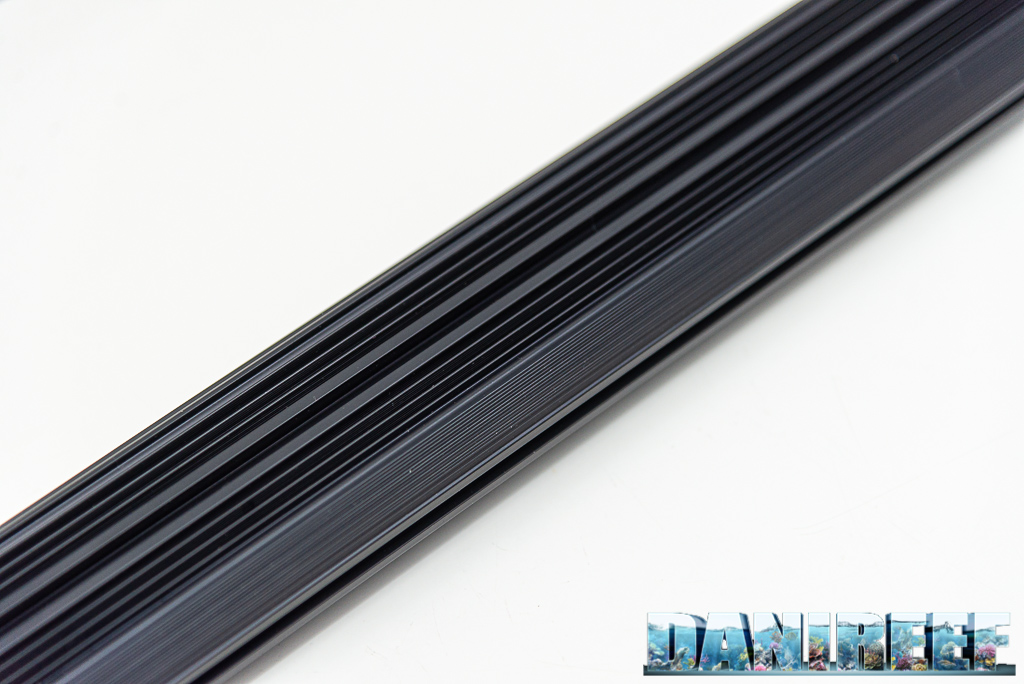
Questions and comments, as always, are welcomed.








